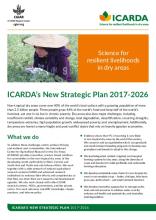Land Library Search
Through our robust search engine, you can search for any item of the over 73,000 highly curated resources in the Land Library.
If you would like to find an overview of what is possible, feel free to peruse the Search Guide.
/ library resources
Showing items 1 through 9 of 27.Key Messages and Recommendations
• Combating desertification and land degradation while mitigating the effects of drought can secure long-term socio-economic benefits for people living in drylands and reduce their vulnerability to climate change.
This publication synthesizes climate characteristics and projections, vulnerability to natural hazards, sectoral climate change impacts, and adaptation priorities in Kazakhstan.
This publication synthesizes climate characteristics and projections, vulnerability to natural hazards, sectoral climate change impacts, and adaptation priorities in Armenia. It outlines rapid onset and long-term changes in key climate parameters, as well as the impact of these changes on co
Presentation on Measurement of the Costs of Land Degradation in the Mountains of the Republic of Tajikistan delivered during the CACIP Regional Consultation Meeting held in Dushanbe, Tajikistan.
In response to the severe economic, social, and environmental costs of degradation across Tunisia’s rangelands, the International Center for Agricultural Research in the Dry Areas (ICARDA) has worked with the General Directorate of Forestry (Direction Générale des Forêts, DGF) to draw up a new pa
This document presents the Strategic Plan of the International Center for Agricultural Research in the Dry Areas for the period from 2017 to 2026.
Non-tropical dry areas cover over 40% of the world’s land surface with a growing population of more than 2.5 billion people. These people grow 44% of the world’s food and keep half of the world’s livestock, yet one in six live in chronic poverty.
Lymantria dispar es una plaga cuarentenaria ausente de Sudamérica, para la que se ha elaborado un plan de vigilancia fitosanitaria regional, debido su elevado riesgo de introducción involuntaria a través del comercio.
The Paris Agreement, adopted in December 2015, represents a new beginning in the global effort to stabilize the climate before it is too late.









